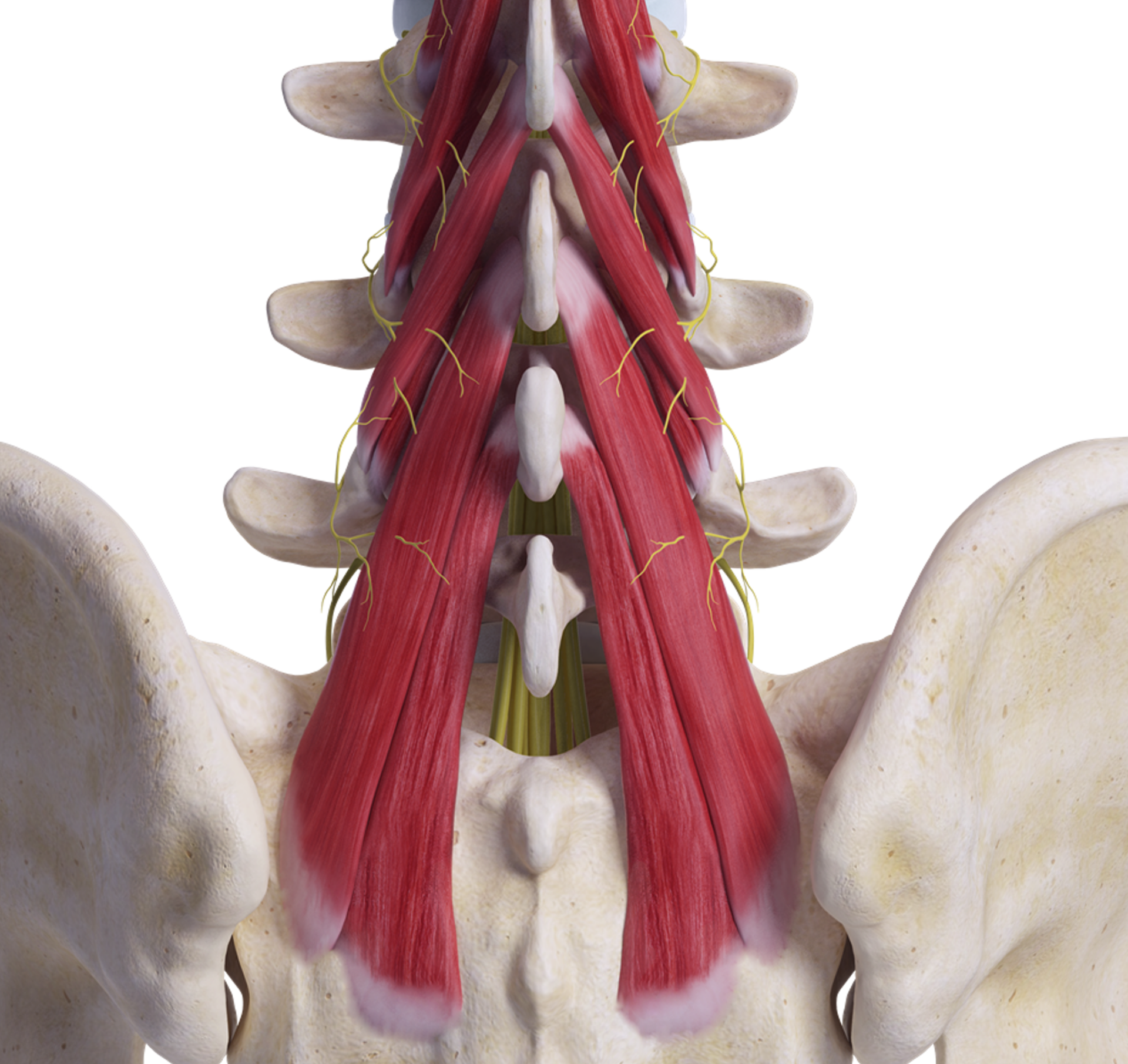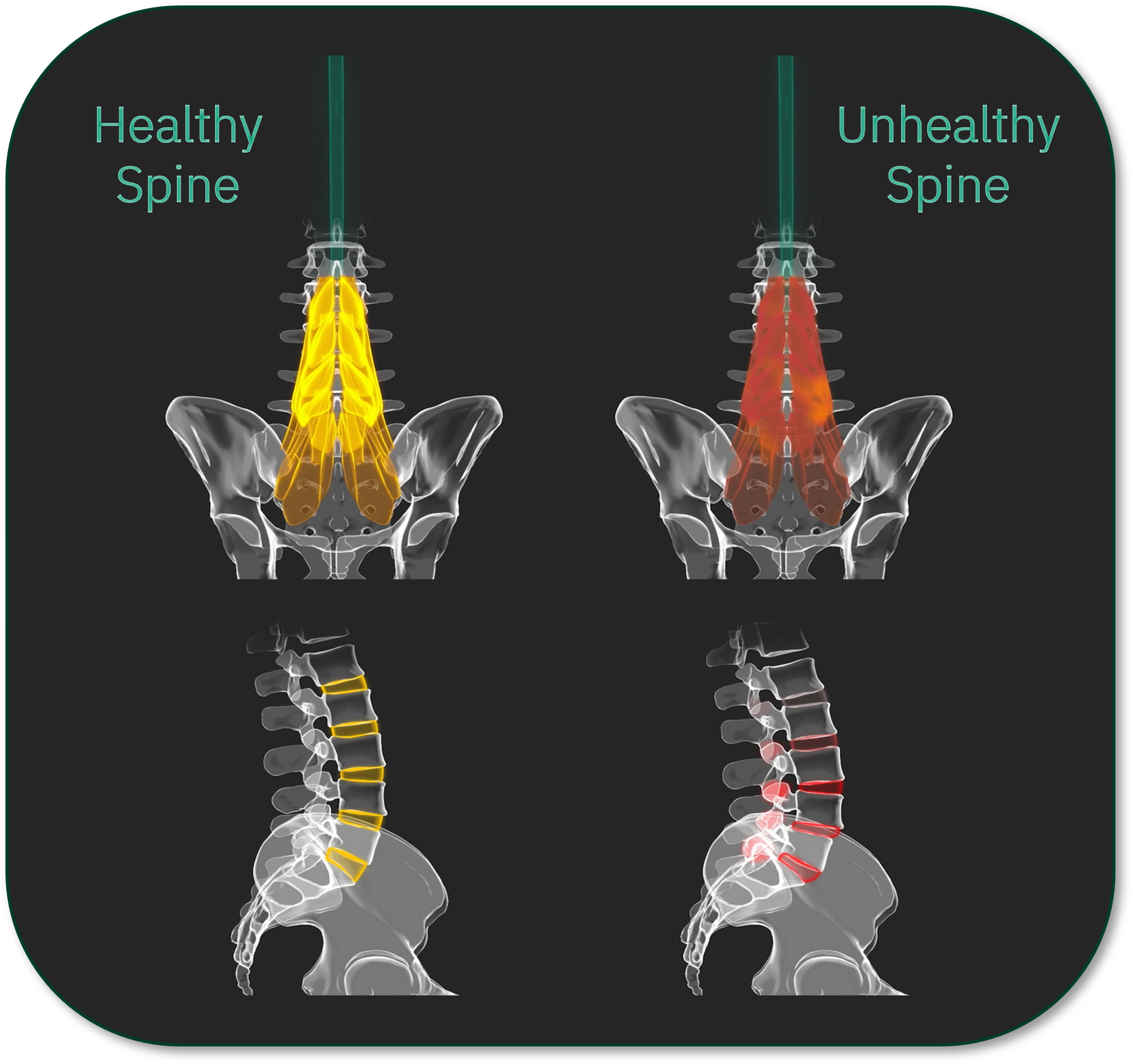Medically reviewed by Dr. Jeremy Joyal, MD and Dr. Matthew T. Ranson, MD: April 1, 2025
Pros and Cons of RFA in Treating Chronic Low Back Pain

Medically reviewed by Dr. Jeremy Joyal, MD and Dr. Matthew T. Ranson, MD
If you suffer from chronic low back pain, you may have tried treatments like physical therapy, medications, or even steroid injections without lasting relief. Many patients are then offered radiofrequency ablation (RFA) by their physicians, a procedure that reduces pain by destroying nerves that send pain signals to the brain.
However, new research suggests that RFA may not be the best option for many cases of chronic low back pain. According to the American Association of Neurological Surgeons (AANS) an estimated 75-85% of Americans experience some form of back pain during their life (Zalatimo). For the two-thirds of patients whose low back pain is caused by mechanical issues (Förster et al), particularly dysfunction in the multifidus muscles, RFA not only fails to address the root cause but may also lead to harmful side effects. Accurate diagnosis and targeted treatment are essential for effective relief.
Here’s what we’ll cover:
- Treating chronic low back pain requires careful consideration of both short-term relief and long-term outcomes.
- While Radiofrequency Ablation (RFA) can provide temporary pain relief, it may worsen chronic back pain over time by further impairing the multifidus muscle—an important stabilizer of the spine—due to nerve damage caused by the procedure.
- ReActiv8 takes a different approach, addressing the root cause of chronic low back pain by directly improving multifidus muscle function.
- It’s important to work with a healthcare provider to find the treatment that best fits your individual needs and goals.
- Understanding your options not only helps you make informed choices but also paves the way for better long-term health and quality of life.

The Multifidus Muscle and Mechanical Chronic Low Back Pain
The lumbar multifidus muscle is a deep spinal stabilizer that spans along both sides of your lumbar spine. It originates from the middle of your spine on each spinal segment and fans out in multiple layers that work together to stabilize your back and protect your spine during movement. The multifidus muscles are also responsible for controlling the position of your vertebrae which helps maintain proper posture. When functioning correctly, it helps prevent mechanical chronic low back pain while sitting, standing, or engaging in physical activities.
Unfortunately, this muscle is prone to inhibition, where it shuts down and ultimately becomes weak. This inhibition and weakness of the multifidus muscle often goes undetected or untreated, leading to mechanical chronic low back pain which is often misdiagnosed as “non-specific.” Low back diagnosis known to be associated with Multifidus Muscle dysfunction include muscle strain or sprain, herniated disc, degenerative disc disease, arthritis, spinal stenosis, and poor posture.


What is Radiofrequency Ablation (RFA) and How Does It Work?
Radiofrequency ablation (RFA) or radiofrequency neurotomy (RFN) is a medical procedure designed to reduce chronic pain by interrupting nerve function. A special needle is placed near the nerves that send pain signals. When turned on, the needle releases radiofrequency energy that gently heats the area. This heat creates small, controlled lesions on the nerve tissue, which act as interruptions in the pathway, preventing pain signals from reaching the brain.
This technique is minimally invasive and is often done on an outpatient basis, making it a popular choice for both patients and healthcare providers.
Many studies have highlighted the success of RFA in considerable pain relief. For instance, research presented in the journal Psychopharmacology Bulletin highlights that patients who underwent RFA experienced significant pain relief, with effects lasting anywhere from six months to a year. This is because ablation of the nerve sending pain signals to the brain does not treat the underlying cause of the pain and the nerves regenerate over time.
Additionally, a new study has emerged that has shown that RFA does have more significant side effects than previously known.
Pros and Cons of RFA
Suppose you are a severe chronic low back pain sufferer considering RFA treatment. In that case, it is important to be confident in the diagnosis of your pain source and be aware of all potential positive and negative outcomes before undergoing treatment. This ensures you can give informed consent, encouraging you to carefully consider the benefits and risks of the procedure.
Long-term vs. Short-term Relief
Radiofrequency ablation offers quick and noticeable relief, but it’s important to recognize that its relief is temporary. Research shows that the pain relief from RFA often decreases over time, usually lasting between six months to a year.
However, the convenience and low invasiveness of RFA make it a popular choice if you’re looking for quick relief without the recovery time that comes with surgery.
Potential Side Effects and Risks of RFA
As with any medical procedure, there are potential side effects and risks associated with RFA. You must discuss these concerns thoroughly with your healthcare provider before deciding on a treatment plan.
Possible side effects of radiofrequency ablation include:
- discomfort post-procedure which is short-lived
- bleeding
- infection
- needle placement induced nerve damage
- burns caused by incorrect grounding pad placement
- neuroma formation
- neuropathic pain
Aside from these accepted side effects and risks of undergoing an RFA procedure, new research has uncovered the potential for additional long-term complications from RFA treatments for pain relief from mechanical chronic low back pain caused by dysfunction in the multifidus muscles.

A 2024 study by Guven et al. indicates that lumbar radiofrequency ablation can harm the multifidus muscle, which is the body’s foundational structure for spinal stability. RFA patients may experience more muscle wasting and fat buildup in the multifidus on the treated side, leading to reduced strength. This may happen because the nerve signals to the multifidus are disrupted. At the same time, the erector spinae muscle, which receives signals from various areas, shows less weakening but more fat on the treated side. This study suggests that while RFA treatments can be an effective short term pain relieving strategy, they are not a “net-neutral” treatment, and the short term benefits may compound any existing multifidus muscle problems that may end up worsening back pain over time.
“Another mechanism of worsening low back pain after Radiofrequency Ablation is that RFAs eliminate a significant amount of pain leading to removal, or lessening, of an important feedback mechanism that can prevent injuries,” explained Dr. Matthew T. Ranson, Interventional Pain Medicine Physician and Medical Director at Gateway Pain Solutions. “Pain is often a warning sign, in many cases, of overuse in patients who have weakened musculature and should not be engaging in certain activities.” This means that patients who have masked their pain symptoms with an RFA could be at greater risk of injury if they attempt to engage in previously painful activities that their bodily structures cannot support.
In light of this new information, proper diagnosis of the pain source of severe chronic low back pain is even more essential. While RFA may still be an appropriate palliative treatment for patients dealing with nerve-related issues, or as a stop gap while waiting for surgery, two-thirds of chronic low back pain patients suffer from mechanical pain (Förster et al). As of recent years, mechanical chronic low back pain has been proven to be much more effectively treated by a new therapy called restorative neurostimulation, using a device called ReActiv8. This development highlights the importance of advocating for yourself to your healthcare provider to ensure an accurately diagnosed pain source so that you can consider all options before pursuing a treatment plan.
ReActiv8 Restorative Neurostimulation is a new therapy intended to treat the cause of mechanical chronic low back pain instead of the symptoms. New evidence suggests that ReActiv8 therapy makes long-term recovery from multifidus muscle issues possible. ReActiv8 is the first FDA-approved treatment with the ability to restore multifidus muscle control, and restoration of function, which gradually reduces chronic low back pain through new stimulation.
According to Dr. Jeremy Joyal of Advanced Spine and Pain, ReActiv8 is an exciting new option for chronic low back pain sufferers. Regarding RFA, he explained that “For a long time, it really was the best we had available to treat mechanical or axial low back pain. We knew there were some short-term and long-term sacrifices to be made using RFA, specifically leading to multifidus muscle atrophy and dysfunction. Now I’m excited to have something that will actually improve a patient’s underlying spinal deconditioning with ReActiv8″.
If you believe you could be among the two-thirds of low back pain patients suffering from mechanical chronic low back pain, click below to learn more:
Learn More About ReActiv8® Today!
RFA: Success Rates and Patient Satisfaction
For patients choosing RFA, studies show that, after 3 years, around 53% of participants reported a 50% reduction in pain. The study also noted that more participants may report less pain if the RFA procedure is repeated. But, as we highlighted above, repeated RFA procedures may lead to multifidus muscle damage and worsening back pain. Additionally, studies evaluating restorative neurostimulation (ReActiv8) show that 52% of patients reported pain resolution after 1 year, as opposed to 6% of patients undergoing personalized optimal medical management treatments, including RFA. Therefore, it’s essential to not only ensure your pain source is accurately diagnosed, but to consider all available treatment options before undergoing multiple RFA procedures.
Cost and Long-term Value
RFA might seem cheaper at first since it usually requires just one procedure and is usually covered by insurance. However, it only provides temporary relief. Many patients end up needing more treatments, which can add up quickly. A study showed that only 33% of patients achieved a successful outcome after three months with RFA, compared to higher success rates with other methods. The costs per successful treatment for RFA were around $6,286, while alternative treatments could be more effective and potentially more cost-efficient in the long run.
Summary of Pros and Cons
Radiofrequency ablation offers several advantages and disadvantages:
| Pros | Cons |
| Provides significant and long-lasting pain relief, lasting 6 months to over a year for many patients. | Pain relief is not permanent; nerves may heal over time, requiring follow-up treatments. |
| Avoids major surgery and leads to quicker recovery times. | RFA may worsen chronic back pain due to multifidus dysfunction, caused by weakening or atrophy of key stabilizing muscles. |
| Specifically targets pain-transmitting nerves without affecting surrounding tissues or muscles. | Risks include infection, bleeding, nerve damage, and temporary numbness or soreness. |
| Performed on an outpatient basis, allowing same-day discharge. | Works better for specific pain types (e.g., facet joint pain) and may not help all conditions. |
| Reduces dependence on painkillers, lowering risks of side effects or addiction. | Can be expensive, and insurance coverage varies by condition and policy. |
Understanding Your Options for Chronic Low Back Pain
While radiofrequency ablation (RFA) may offer temporary, quick relief for chronic back pain, it is crucial to consider the potential for worsening pain over time for those suffering from mechanical pain caused by multifidus muscle dysfunction. When exploring treatment options, patients should weigh the short-term relief RFA provides against the long-term implications on muscle health and stability.
Speak with your healthcare provider to determine the best course of action for your specific needs. Consider advocating for a reevaluation of your pain source or a second look at your MRI. If the underlying cause of your chronic low back pain is actually mechanical in nature, you could stand to benefit greatly from considering alternative options like ReActiv8.
Remember, understanding all available treatment options is key to making an informed decision that will ultimately lead to improved quality of life and reduced pain. No one should live their lives in constant pain. If you have mechanical chronic low back pain, you may be able to treat the cause of your pain, not only the symptoms.